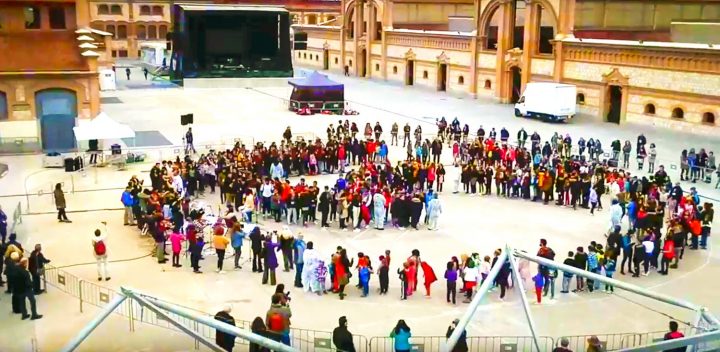The day after officially launching the 2nd World March for Peace and Nonviolence, we had the opportunity, to speak with its coordinator, Rafael de la Rubia, from the international humanist association, World without Wars and Violence, at the end of the event to form the symbols of peace and nonviolence with young people from various schools in Madrid.
Pressenza: How did it go yesterday?
Rafa de la Rubia: Well, a lot of things. It is a synthesis of a stage; a stage of preparation and something that we had already decided to do about a year ago, but what happened yesterday is the firm commitment to do a second march with the sensation that it can have a lot of support, and surely it is very necessary given the situation that exists.
Video by Álvaro Orús with subtitles in English
PZ: How do you feel now that the countdown has begun?
RR: Good. I think much better than before, because before I was kind of uncertain. You always have the possibility to say, “Well, let’s take a step back” or not. Now it’s launched and I think it’s more relaxed. It’s a lot of work.
PZ: What will the second march be like? Are people around the world expected to be inspired and join in with their actions?
RR: First, that’s what we want, for people to be inspired! In what? Whatever. Whatever. And yesterday we showed a bit of the diversity of all that, and we didn’t have time to talk about all the things that are developing. So what we’re really trying to do is that people who have a need, who have a problem, or who have an inspiration, or who have an intuition that something could be done, and we encourage them to dive right in, as they say, right? but to do it in a small way, to make that action small, observe it, measure it, and then scale it up. We invite them to escalate it, to increase in number of people or in number of cities or places, or in a much higher quality.
So start small, but aspire to get bigger. It is this phrase that we know “think globally and act locally” that we could reformulate as another phrase that says “acting locally while thinking of acting globally”.
PZ: The main subject of this march is the elimination of nuclear weapons…
RR: The first point of the first world march was to try to fight for the eradication of nuclear weapons, just as chemical and biological weapons have been eradicated. And in this case it is going to be reinforced given the treaty on the prohibition of nuclear weapons that the United Nations approved – backed by 122 countries. There are conditions so that – and this is what we are going to aim for – at the end of the World March, in those 50 minimum countries that ratify it, the treaty on the prohibition of nuclear weapons enters into force, which would be an historic step.
PZ: How can people find more information and get in touch?
RR: Well, there’s a website already – in development – that I don’t know how to say it because it’s in English: www.the2worldmarch.org










